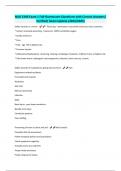NUR 2349 Exam 1 Fall-Rasmussen-Questions with Correct Answers/
Verified/ latest Update (2024/2025)
Safety hazards in a home - ✔️✔️* Poisoning - medication, household chemicals, lead, cosmetics.
* Carbon monoxide poisoning - treatment- 100% humidified oxygen.
* Scalds and burns
* Fires
* Falls - age >65 at highest risk
* Firearms injuries
* Suffocation/Asphyxiation- drowning, choking, smoke/gas inhalation, children 0-4yrs at highest risk.
* Take home toxins- pathogenic microorganisms, asbestos, lead, mercury, arsenic.
Safety hazards in hospital/care giving environment - ✔️✔️Falls
Equipment-related accidents
Fires/electrical hazards
Restraints
Side rails
Mercury poisoning
Infection
Spills
Back injury - poor body mechanics
Needle stick injury
Combative patients
Poor staffing
Preventing of harm to client and self - ✔️✔️Wash hands!
Complete fall risk assessment
Follow hospitals policies and procedures
Check equipment regularly
Actually assess your patients
Proper body mechanics
Proper disposal of sharps
,Radiation precautions
Environmental Awareness
Prevention of choking - ✔️✔️- Suffocation by smothering is the leading cause of death for infants
younger than 1 year.
- Suffocation may be caused by drowning, choking, or inhaling gas or smoke.
- Beware of small foods with small children, including hot dogs, raw vegetables, popcorn, hard
candies, nuts, and grapes. They are responsible for most non-fatal choking.
- Nonfood items, such as latex balloons and plastic bags, cause the majority of suffocation deaths in
young children.
- Suffocation of infants is often related to bed or crib hazards, such as excess bedding or pillows, or
toys hung from long ribbons inside the infant's crib.
Fire Precautions - ✔️✔️R.A.C.E
Rescue
Alarm
Contain
Extinguish
Poisoning - ✔️✔️Poisoning-household chemicals, lead, medicines, cosmetics. Prevention- cabinet
locks, store poisons high, keep poison control number available. Treatment depends on the poison
ingested -
antidotes most often activated charcoal.
Do NOT induce vomiting for acidic material ingested
Carbon Monoxide Poisoning - ✔️✔️- Carbon monoxide (CO) is a colorless, tasteless, odorless toxic
gas. Exposure can cause headaches, weakness, nausea, and vomiting; prolonged exposure leads to
seizures, dysrhythmias, unconsciousness, brain damage, and death.
- Do not use unconventional heating inside such as grill, or gas range
- Use of detectors and change batteries every 6 months.
Mercury Poisoning - ✔️✔️Products containing mercury include thermometers, thermostats,
batteries, fluorescent light bulbs, blood pressure devices, and electrical equipment and switches.
,To prevent have yearly facility training and follow facility policy
Communication - ✔️✔️- Educate patients
- Communicate specifics to tech
- Shift-to-shift report
- Use SBAR - specifically with physicians
- Use patient names - more specific
- Follow-up - if you say an hour, do it!
- Never walk past a call light
- Document accurately
Walker - ✔️✔️Handgrip at greater trochanter
Elbow flexed 20-30 degree
Walker followed by affected side then unaffected side.
Cane - ✔️✔️Handgrip at greater trochanter
Elbow flexed 15-30 degree
Use on UNAFFECTED side
Place cane 4-6" to side stronger foot
Move cane and affected leg at same time when walking, then unaffected leg
Crutches - ✔️✔️Arms/hands bear weight
Up stairs=good first
Down stairs=bad first
When walking crutch goes 6-10" in front
Crutches go to affected side when sitting
Pad 2 inches below axilla, 4 inches to side of heel Elbow flexed 20-30 degree when walking
Fall risks and prevention - ✔️✔️Cognition, balance, gait, mobility, vision, peripheral neuropathy,
awareness, medications. Toddlers, elderly most at risk.
, Bed to lowest point, only 2 guardrails left up, non-slip socks, remove throw rugs, remove clutter,
orient to room, make sure patient knows how to use canes/walkers/crutches, call light within reach,
prepare a fall assessment, clean, dry floors
Infants (1month- 1 year) Safety - ✔️✔️Falls
SIDS (back to sleep)
Injury from toys
Burns
Suffocation and choking
Electrocution
Ingestion of foreign bodies
Child mistreatment
Toddler (1-3years) - ✔️✔️Drowning (second to MVA)
Falls (primary cause of non-fatal injury)
Cuts
Concussions
Guns and weapons (locked and unloaded)
Escape from home
Poison (Poison Control # on fridge)
Suffocation and choking
Child mistreatment
Preschooler (3-6 years) - ✔️✔️Drowning
Falls
Cuts
Firearms
Strangers
Burns
Motor Vehicles
Poisoning




